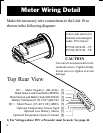
18
Although the Link 10 is a very sophisticated device, obtaining basic battery
information from it is simple. With the unit turned on and the (Volts) LED on,
let's learn how to display the four most important DC system parameters.
When you touch the button, you
are SELecting the display you wish.
Each time you touch SEL in normal
operation, you will toggle to the next
item to the right
(volts) goes to
(amps) to (amp hours) to (time).
Now press SEL to bring up these functions.
Operation
Volts is the electric potential to do work. Voltage is useful to assess the
approximate state-of-charge and to check for proper charging. Examples:
An at-rest, fully charged battery will show about 12.8 V. A 12 V battery
is 100% discharged when it reaches 10.5 volts with a 20-hour rated load
applied. A typical charging voltage would be 14.2 V.
Amps is the present flow of current in or out of the battery. For example,
a refrigerator may draw 6 amps of current. This is displayed as
- 6.0 (6
amps are being consumed). Discharge is shown as a negative number and
charging is shown as a positive number (unsigned).
Amp hours consumed represents the amount of energy removed from
the battery. If you run a 10-amp load for one hour then ten amp hours are
consumed. The Link 10 will show
-I0 in the display. During charging
the Link 10 will compensate for charging efficiency and count back up
toward 0.
Time is an estimate of how long (in hours) the battery will sustain a load.
It is based on a selectable, time averaged, rate of discharge. Default is the
average of the last four minutes of use (see page 24).
i4.25


















